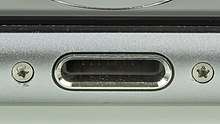Pentalobe security screw
The pentalobe security screw[1] (Apple nomenclature), or pentalobe screw drive, is a five-pointed tamper-resistant system used by, but not limited to, Apple in their products.[1] Pentalobe screws were adopted by Apple starting in 2009, when they were first implemented in the 15-inch MacBook Pro. They have since been used on other MacBook Pro, MacBook Air and iPhone models. Apple attracted criticism upon the introduction of the pentalobe screw; it was seen by some as an attempt to lock individuals out of their devices.[2] However, since then, inexpensive pentalobe screwdrivers, manufactured by third parties, have become relatively easy to obtain.[3]
 Pentalobe screw diagram | |
| Inception | 2009 |
|---|---|
| Manufacturer | Apple |
| Available | In use |
| Notes Tamper resistant screw | |
Pentalobe screw sizes include TS1 (0.8 mm, used on every iPhone after and including the iPhone 4), TS4 (1.2 mm, used on the MacBook Air and the MacBook Pro with Retina display), and TS5 (1.5 mm, used on the 2009 MacBook Pro battery). The TS designation is ambiguous as it is also used for the Torq-set screw drive.
Usage
| Part of a series on |
| Screw drive types |
|---|
| Slotted |
| Cruciform |
| External polygon |
| Internal polygon |
|
| Hexalobular |
| Three-pointed |
| Special |
iPod
Various models of the iPod Classic include pentalobe screws on its Toshiba hard drive.
MacBook Pro
The first Apple product to include pentalobe screws internally was the Mid 2009 MacBook Pro 15-inch model. Three pentalobe screws were used to attach the battery to the internal frame. A 1.5 mm flat-blade (slotted) screwdriver could easily remove these screws, which were originally mistaken for 5-point Torx screws.[4] This was the only internal usage of pentalobe screws; all following MacBook Pros use the "Tri-Wing" security bit to attach the battery to the internal frame, or else have glued-in batteries.
Pentalobe screws reappeared in the mid-2012 version of the MacBook Pro. Eight 3 mm and two 2.3 mm pentalobe screws were used externally to attach the bottom plate of the case to the internal frame.[5] The late-2012 version of the 13-inch MacBook Pro was the first 13-inch model to have pentalobe screws; several were used externally in a similar fashion to the 15-inch mid-2012 MacBook Pro.[6] None of the three 17-inch models of the MacBook Pro have used any pentalobe screws.
MacBook Air
The MacBook Air has seen more extensive use of pentalobe screws than the MacBook Pro. All five versions of the 11-inch MacBook Air (late-2010, mid-2011, mid-2012, mid-2013 and early-2014) include eight 2.5 mm-long and two 8 mm-long external pentalobe screws.[7] The last five versions of the 13-inch MacBook Air (late-2010, mid-2011, mid-2012, mid-2013 and early-2014) use eight 2.6 mm-long and two 9 mm-long pentalobe screws.[8] Pentalobe screws have been used only externally on MacBook Air models.
Third-party manufacturers have marketed a variety of 5-point screwdrivers that fit pentalobe screws on MacBook models since pentalobe screws first appeared externally in the late-2010 MacBook Air.
iPhones
The original iPhone had no screws holding the body together. The iPhone 3G and the iPhone 3GS had two #00 Phillips screws next to the 30-pin Dock Connector.
Pentalobe screws were first used in the iPhone 4. At first, #00 Phillips screws were used, but later iPhone 4 models had pentalobe screws.[9] The screws used were slightly smaller than a Torx TS1, about 0.8 mm. If brought in to an Apple Store for repair, iPhone 4 models with #00 Phillips screws, if any, were replaced with 0.8 mm pentalobe screws.[10] Third-party manufacturers rushed to produce screwdrivers that would remove 0.8 mm pentalobe screws after the iPhone 4's release in June 2010. These inexpensive, easily purchased drivers will remove pentalobe screws quite easily. Many are sold as "kits" containing a 5-point driver and Phillips #00 screws, in order to replace pentalobe screws with easily removable Phillips screws. Most other security screwdrivers will strip the miniature heads, effectively locking the user out of their device.
All iPhone 4S models contain identical pentalobe screws to those found on the iPhone 4. The iPhone 5 has very similar 0.8 mm pentalobe screws, but the screws have longer 3.6 mm shafts.[11]
Non-Apple manufacturers
Huawei used pentalobe screws for the Huawei P9, a decision criticised by Kyle Wiens writing for Wired, because using pentalobe screws instead of standard screws like Torx makes electronics more difficult to repair. Its successor, the Huawei P10, also used pentalobe screws to secure the back cover to the phone.[12]
Like Huawei P9, Meizu MX9 also uses the pentalobe screw next to the USB-C connector.[13]
Sizes and measurements
Although there is no (known) official standard naming scheme, the size is commonly known as P-sizes. TS-sizes are sometimes used, but leave room for mixing up with regular Torx sizes. The following P and TS sizes are used by iFixit.com, and PL sizes by Wiha, a German tool company:
| P sizes | TS sizes | PL sizes[14] | Dimension | Usage |
|---|---|---|---|---|
| P1 | TS0 | Unknown | ||
| P2 | TS1 | PL1 | 0.8 mm | iPhone 4 (Late), 4S, 5, 5C, 5S, 6, 6 Plus, 6S, 6S Plus, SE, 7, 7 Plus, 8, 8 Plus, iPhone X, Huawei P9 |
| P3 | TS2 | Unknown | ||
| PL2 | 0.9 mm | Apple Watch Band, M1.2 thread | ||
| P4 | TS3 | Unknown | ||
| PL3 | 1.1 mm | |||
| P5 | TS4 | PL4 | 1.2 mm | MacBook Air and MacBook Pro with Retina Display |
| P6 | TS5 | PL5 | 1.5 mm | MacBook Pro (2009) Battery - 15” only. Also known as Apple specialty tool 922-9101 |
| PL6 | 1.6 mm |
These pentalobe, 5 point heads are not to be confused with Torx Plus Security heads which have 6 points. A "IPR" designation identical to "PL" is sometimes seen due to the confusion. It is possible that ambiguous "TS" nomenclature is the same as the "PL" designation when referring to Pentalobe screws.
Apple simply refers to the screws by their millimeter dimensions. For example, the PL2 screw used on the lugs that hold the Apple Watch Band is called "Pentalobe 1.1".[15]
References
- Wiens, Kyle (January 20, 2011). "Apple's Diabolical Plan to Screw Your iPhone". ifixit.com. Retrieved January 28, 2012.
- Foresman, Chris (January 20, 2011). "Apple "screwing" new iPhones out of simple DIY repair". Ars Technica. Retrieved January 28, 2012.
- Ray, Bill (January 24, 2011). "The cost of beating Apple's shrewd screws? £2". The Register. Retrieved February 14, 2018.
- Galan, Walter. "Installing MacBook Pro 15" Unibody 2.53 GHz Mid 2009 Battery". Repair Guide. ifixit.com. Retrieved January 28, 2012.
- Wiens, Kyle. "MacBook Pro 15" Retina Display Mid 2012 Teardown". Repair Guide. ifixit.com. Retrieved January 28, 2012.
- "MacBook Pro 13" Retina Display Late 2012 Teardown". Repair Guide. ifixit.com. Retrieved January 28, 2012.
- "MacBook Air 11" Late 2010 Teardown". Repair Guide. ifixit.com. October 10, 2011. Retrieved January 28, 2012.
- Bookholt, Andrew. "Installing MacBook Air 13" Late 2010 Battery". Repair Guide. ifixit.com. Retrieved January 2, 2012.
- Brown, Mark (January 21, 2011). "Apple locks down new iPhone 4s with tamper-resistant screws". Wired. wired.co.uk. Retrieved January 28, 2012.
- Kaneshige, Tome (January 20, 2011). "The Case of Apple's Mystery Screw". International Data Group. Retrieved January 28, 2012.
- Goldberg, Andrew. "Installing iPhone 5 Battery". Repair Guide. ifixit.com. Retrieved January 28, 2012.
- Wiens, Kyle (May 6, 2016). "Huawei Just Copied the iPhone—Down to the Last Screw". Wired. Retrieved February 26, 2017.
- Kay Kay Clapp (21 April 2018). "Bit History: The Pentalobe". iFixit. Retrieved 2 December 2019.
- "Fine screwdriver PicoFinish Pentalobe". wiha.com. Retrieved March 22, 2019.
- "Band Design Guidelines for Apple Watch, R3" (PDF). Apple. 2015-12-18. Archived from the original (PDF) on 2018-09-08. Retrieved 2 December 2019.
